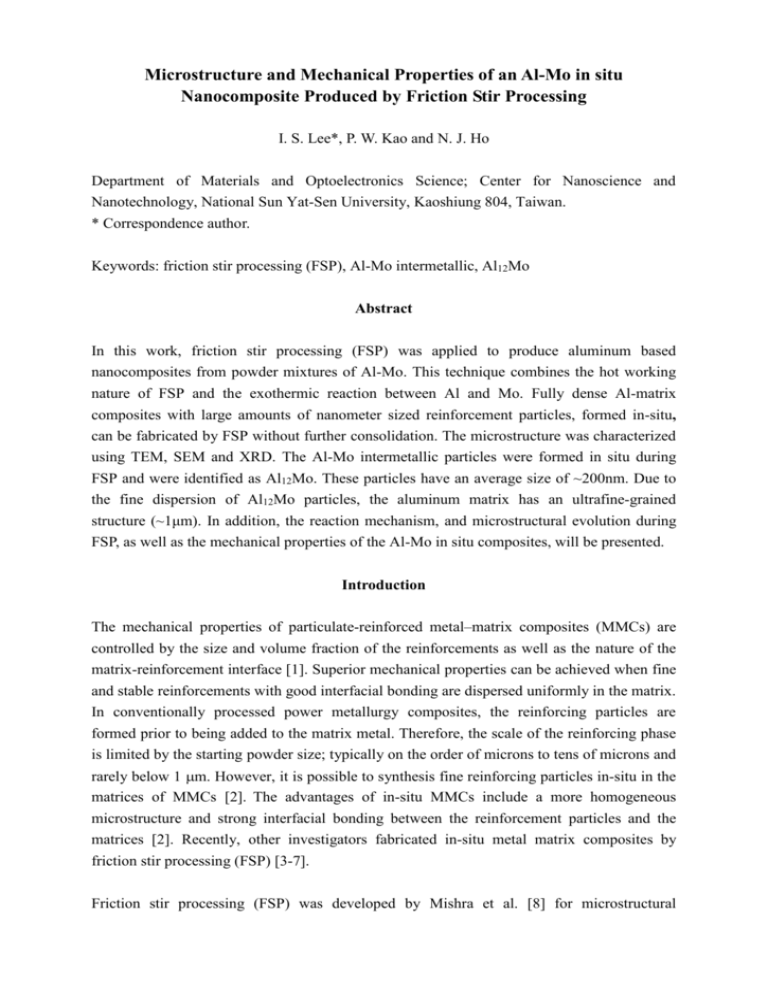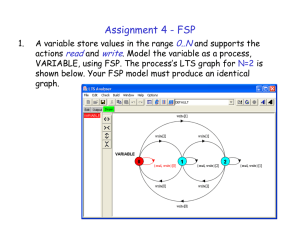References
advertisement

Microstructure and Mechanical Properties of an Al-Mo in situ Nanocomposite Produced by Friction Stir Processing I. S. Lee*, P. W. Kao and N. J. Ho Department of Materials and Optoelectronics Science; Center for Nanoscience and Nanotechnology, National Sun Yat-Sen University, Kaoshiung 804, Taiwan. * Correspondence author. Keywords: friction stir processing (FSP), Al-Mo intermetallic, Al12Mo Abstract In this work, friction stir processing (FSP) was applied to produce aluminum based nanocomposites from powder mixtures of Al-Mo. This technique combines the hot working nature of FSP and the exothermic reaction between Al and Mo. Fully dense Al-matrix composites with large amounts of nanometer sized reinforcement particles, formed in-situ, can be fabricated by FSP without further consolidation. The microstructure was characterized using TEM, SEM and XRD. The Al-Mo intermetallic particles were formed in situ during FSP and were identified as Al12Mo. These particles have an average size of ~200nm. Due to the fine dispersion of Al12Mo particles, the aluminum matrix has an ultrafine-grained structure (~1μm). In addition, the reaction mechanism, and microstructural evolution during FSP, as well as the mechanical properties of the Al-Mo in situ composites, will be presented. Introduction The mechanical properties of particulate-reinforced metal–matrix composites (MMCs) are controlled by the size and volume fraction of the reinforcements as well as the nature of the matrix-reinforcement interface [1]. Superior mechanical properties can be achieved when fine and stable reinforcements with good interfacial bonding are dispersed uniformly in the matrix. In conventionally processed power metallurgy composites, the reinforcing particles are formed prior to being added to the matrix metal. Therefore, the scale of the reinforcing phase is limited by the starting powder size; typically on the order of microns to tens of microns and rarely below 1 m. However, it is possible to synthesis fine reinforcing particles in-situ in the matrices of MMCs [2]. The advantages of in-situ MMCs include a more homogeneous microstructure and strong interfacial bonding between the reinforcement particles and the matrices [2]. Recently, other investigators fabricated in-situ metal matrix composites by friction stir processing (FSP) [3-7]. Friction stir processing (FSP) was developed by Mishra et al. [8] for microstructural modification based on the principle of friction stir welding (FSW); a solid state welding technique invented in 1991 at The Welding Institute [9]. In FSP, a rotating tool, with pin and shoulder, is inserted and moved along the material providing localized heating and plastic deformation. The material experiences very large plastic strain (εeff > 40) by being extruded around the rotating tool [10]. A comprehensive literature review on friction stir welding has been given by Mishra and Ma [11], and a review on the recent developments in FSP was provided by Ma [12]. Aluminum reinforced with large amounts (up to ~50 vol. %) of nanometer-sized Al3Ti particles was fabricated from Al–Ti elemental powder mixtures via friction stir processing (FSP) [5]. These authors suggested that the rapid Al-Ti reaction in FSP is a combined result of the large plastic strain and high temperature introduced during FSP and the exothermic reaction between Al and Ti. In MMCs, high reinforcement volume fractions are typical, giving rise to excellent properties. Furthermore, Al–TM (TM: transition metals) alloys are expected to show superior elevated temperature mechanical property because of the microstructure stability originating from the low diffusivity of TM in Al. In this work, the Al-Mo binary system was investigated because Mo has very low diffusivity and solubility in Al [13]. The objective of the present study is to produce ultrafine-grained aluminum reinforced by large amounts of nanometer-sized Al–Mo intermetallic particles formed in-situ and dispersed in the aluminum matrix during FSP. Experimental In this work, a powder mixture of Al-5 at. % Mo (denoted as Al-5Mo) was prepared from pure aluminum powder (99.7% purity, -325 mesh), and pure molybdenum powder (99.99% purity, 4μm). After proper mixing, the Al–5Mo powder was cold compacted to a billet of 12×12×88 mm3 in a steel die set by using a pressure of 225 MPa. To improve the billet strength for easier handling during FSP, the green compact was sintered in Ar at 823°K for 20 min. The tool pin used during FSP was the standard M1.2*6 (diameter of 6 mm and pitch height of 1.2 mm). The tool spindle angle (angle between spindle and workpiece normal) was 3o. The rotating tool was traversed along the long axis of the billet. Based on trial studies, a tool-rotation speed of 1400 rpm, traverse speed of 30-45 mm/min, and four FSP passes were applied to give defect free specimens consistently. For multiple FSP passes, the rotating tool was moved along the same line for each pass and was applied after the workpiece had cooled to room temperature from the previous pass. X-ray diffraction (XRD, CuK, 40 kV, 30 mA) was used to identify the phases present in the specimens andcanning electron microscopy (SEM, JSM-6330) used to study the distribution of second phase particles. Thin foils prepared by ion-milling were examined using transmission electron microscope (Tecnai F20 G2 Field-Emission TEM) operated at 200 kV. The Vickers microhardness was measured with a 300 gm load for 15 sec. Mechanical properties of specimens machined from the stirred zone (SZ) were measured on an Instron 5582 universal testing machine with an initial strain rate of 1×10-3 s-1. The dimensions of the gauge section of the tensile specimens were 3 mm in diameter and 14 mm in gauge length. For tension tests, the loading axis was parallel to the FSP tool traversing direction. Results and Discussion The X-ray diffraction pattern indicates no reaction between the Al and Mo during sintering, figure 1, line C. After four FSP passes, diffraction peaks corresponding to the Al12Mo intermetallic phase appear in the XRD pattern (Fig. 1, lines A and B). In addition, the lower tool traveling speed (30mm/min) produces a larger amount of Al12Mo intermetallic phase. However, the diffraction peaks corresponding to Mo still exist in the sample produced by 4 FSP passes. This indicates that the Al-Mo reaction was not completed after 4 FSP passes. 3000 Al12Mo # Mo Al Al 1400/30 (A) 1400/45 (B) 550oC sinter (C) # Intensity # Al 2000 # # Mo ## ## Al Mo # ## Al Mo (A) 1000 (B) 0 (C) 20 40 60 80 2 Figure 1. XRD patterns for (a) specimen processed by 4 FSP passes (1400rpm-30mm/min), (b) specimen processed by 4 FSP passes (1400rpm-45mm/min), and (c) as-sintered specimen. The cross-section of the stirred zone in specimens produced by FSP was examined using SEM. The microstructure of the as-sintered condition is shown in Fig. 2a, and can be characterized as a dispersion of clusters of fine Mo particles in an aluminum matrix. The typical microstructure in the stir zone after 4 FSP passes is shown in Fig. 2b, and shows a uniform dispersion of second phase particles of submicrometer size. Three phases, each differing in contrast can be characterized in the BEI images (Figs. 2b and 2c). The brightest phase is Mo, the gray phase is Al12Mo, and the dark gray matrix is Al. The reaction between Al and Mo is not complete even after 4 FSP passes because Mo particles still exist in the stirred zone. Figure 2. SEM backscattered electron image (BEI) showing the microstructure of (a) as-sintered condition, and in the stirred zone of specimens produced by 4 FSP passes (b) 1400 rpm - 45 mm/min, and (c) 1400 rpm – 30 mm/min. ( The microstructure of the SZ in specimens produced by FSP was also examined by the use of TEM. Typical microstructures are shown in Fig. 3. As shown in Fig. 3a, large amounts of fine second phase particles are uniformly distributed in the aluminum matrix. The average size of the aluminum grains, as revealed by the dark field image, is about 2m (Fig. 3b). In general, the second phase particles have an equiaxed shape as shown in Fig. 3(c), and the average size of second phase particles is about 200 nm. Figure 3 The microstructure of FS processed specimens revealed by TEM.( 1400 rpm – 30 mm/min, 4 FSP passes) (a) Bright field image showing nanometer size particles distributed in the aluminum matrix, (b) dark field image showing fine Al12Mo particles dispersed in an aluminum grain, and (c) Al12Mo particle revealed by dark field image. During FSP, the time that the material is subjected to the thermomechanical action is very short, i.e., only on the order of tens of seconds. The reaction between the Al and Mo must proceed very fast during FSP. The large plastic strain in FSP can shear the metal powders and break the oxide film surrounding Al and Mo powders causing intimate contact between the Al and Mo accelerating the reaction. The reaction product can be effectively removed from the interface by the large plastic strain realized during FSP such that direct contact between the Al and Mo can be maintained, and consequently, the reaction can proceed rapidly at the interface. In addition, as suggested by Hsu et al.,, the heat release associated with the Al-TM reaction at the interface might cause local melting of Al, possibly further enhancing the reaction between Al-TM [3,4]. Decreasing the FSP traveling speed will enhance the Al–Mo reaction, resulting in more reinforcement particles, and higher hardness. The average hardness in the stirred zone of specimens produced by 4 FSP passes can be raised from 62 Hv to 74 Hv by decreasing the tool traveling speed from 45 to 30 mm/min. The tensile stress-strain curve of the specimen produced by 4 FSP passes with a tool travel speed of 30 mm/min is shown in Fig. 4, where the results of Al-10Ti [4] and Al-10 Fe [6] are also shown for comparison. The tensile properties of Al-5Mo, Al-10Ti [4] and Al-10 Fe [6] are summarized in Table 1. All the Al-TM composites shown in Table 1 have enhanced Young’s modulus as compared to that of aluminum (70 GPa). Such improvement in the bulk modulus can be attributed to the presence of large amounts of the intermetallic phases in the composite, each having high moduli, i.e., E = 216, 130, and 116 GPa for Al3Ti, Al13Fe4, and Al12Mo, respectively. Due to the presence of large amounts of nanometer sized reinforcing particles and the UFG structure of the aluminum matrix, the Al-5Mo composite exhibits high strength. As compared with Al-10Ti [4] and Al-10 Fe [6], Al-5Mo also has good tensile ductility (~16.5%). However, the strength of Al-5Mo is inferior to that of Al-10Ti. This may be attributed to the coarser particles (~200 nm) in the Al-5Mo as compared to 83 nm in Al-10Ti [4]. The lower strength in the Al-Mo system also may be affected by the incomplete reaction in the Al-5Mo. If Mo in the Al–5Mo composite is fully reacted, the volume fraction of Al2Mo can reach 0.69. This should provide a considerable strengthening effect. Based upon this work and previous studies [3-6], it is suggested that more research work is needed in the following two aspects: (1) to enhance the rate of the in-situ reaction during FSP, and (2) to reduce the size of the reinforcement particles formed by the in-situ reaction. Besides the processing parameters of FSP, several factors may be considered such as: (a) thermodynamic characteristics of the reactants such as heat release in the reaction, (b) particle size of the reactants, and (c) the stability of the reinforcement phase at elevated temperature, which may be affected by the melting point, and the diffusivity and solubility of the constituent elements in the aluminum matrix. Sample Table 1. Tensile properties of Al–TM composites produced by FSP σy (MPa) E (GPa) UTS (MPa) Elongation (%) Al-5Mo 78 160 177 16.5 Al-10Fe [6] 91 177 217 3.7 Al-10Ti [4] 86 316 366 7.2 450 Al-5Mo Al-10Fe [6] Al-10Ti [4] True stress (MPa) 400 350 300 250 200 150 100 50 0 0.00 0.02 0.04 0.06 0.08 0.10 0.12 0.14 0.16 0.18 True strain Figure 4. Tensile stress-strain curves of specimens produced by FSP. Summary In this work, an Al-Mo in-situ composite was successfully produced by using a technique combining friction stir processing (FSP) and the exothermic reaction between Al and Mo. The Al-Mo intermetallic particles, identified as Al12Mo, were formed in-situ during FSP. The microstructure of the composite can be characterized as a fine dispersion of nanometer sized Al12Mo particles (~200nm) in an aluminum matrix with an ultrafine-grained (UFG) structure (~2μm). Due to the presence of large amounts of nanometer sized reinforcing particles and the UFG structure of aluminum matrix, the composite exhibits both high strength and good ductility. 1. 2. 3. 4. 5. 6. 7. References T.W. Clyne, P.J. Withers, An Introduction to Metal Matrix Composites, Cambridge, Cambridge University Press; 1993. S.C. Tjong, Z.Y. Ma, “Microstructural and mechanical characteristics of in situ metal matrix composites”, Mater. Sci. Eng. A 29 (2000) 49–113. C.J. Hsu, et al., Scripta Mater 53 (2005) 341. C.J. Hsu, et al., “Al-Al3Ti Nanocomposites Produced in situ by Friction Stir Processing”, Acta Materialia 54(2006) 5241-5249. C.J. Hsu, et al., ”Intermetallic-reinforced aluminum matrix composites produced in situ by friction stir processing”, Materials Letters 61(2007) 1315-1318. I.S. Lee, et al., ”Microstructure and mechanical properties of Al–Fe in situ nanocomposite produced by friction stir processing”, Intermetallics 16 (2008) 1104–1108. Z.Y. Ma, J.H. Li, M. Luo, X.G. Ning, Y.X. Lu, J. Bi and Y.Z. Zhang, “In-situ formed Al2O3 and TiB2 particulates mixture-reinforced aluminum composite”, Scripta Metall. Mater. 31 (1994) 635-639 8. 9. 10. 11. 12. 13. R.S. Mishra et al., ”High strain rate superplasticity in a friction stir processed 7075 Al alloy”, Scripta Mater, 42 (2000), 163-168. W.M. Thomas et al., “Friction Stir Butt Welding”, G.B. Patent Application No. 9125978.8, December 1991; US Patent No. 5460317, October 1995. P. Heurtier et al., ”A thermomechanical analysis of the friction stir welding process”, Mater Sci Forum, 396-402 (2002), 1573-1542. R.S. Mishra, Z.Y. Ma, Mater Sci Eng R 2005;50:1. Z.Y. Ma, “Friction Stir Processing Technology: A Review”, Met and Mater A, 39 (2008) 642-658. W.F. Gale, T.C. Totemeier. Smithells Metals Reference Book, 8th ed. Elsevier; 2004.






